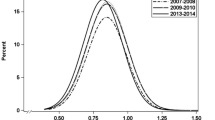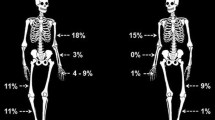Abstract
There is scarcity of population-level data on the bone areal size (BA) that produces the highest bone mineral density (BMD), and how BA relates to BMD among racial groups. We use population-level data to estimate the BA that coincide with the highest BMD among racial groups in the United States. A total of 7425 participants, age 18–75 years, whose BA and BMD were measured in the United States National Health and Nutrition Examination Survey (NHANES) 2009–2014, were assessed in this study. Multiple regression models were used to estimate race-specific relationships between BA and BMD. The critical BA that associates with the highest (peak) BMD among racial groups adjusted for confounders was estimated. Results showed a curvilinear relationship between BA and BMD at the population level such that BMD increases with BA at lower values and then decreases after a peak value. Races combined, BA of about 45 cm2 seems to correspond to a peak femur BMD in this sample. The peak BMD was different among racial groups. The BA at which BMD peaks was lower among blacks and Mexicans compared to whites. We conclude that femur BMD increases up to a critical femur BA and then decreases thereafter. Persons with femur BA at or close to the critical value may tend to have higher than average BMD.



Similar content being viewed by others
References
Deng HW, Xu FH, Davies KM, Heaney R, Recker RR (2002) Differences in bone mineral density, bone mineral content, and bone area in fracturing and nonfracturing women, and their interrelationships at the spine and hip. J Bone Miner Metab 20(6):358–366
Brazerol WF, McPhee AJ, Mimouni F, Specker BL, Tsang RC (1988) Serial ultraviolet B exposure and serum 25 hydroxyvitamin D response in young adult American blacks and whites: no racial differences. J Am Coll Nutr 7:111–118
Looker AC, Melton LJ, Harris T, Borrud L, Shepherd J, McGowan J (2009) Age, gender, and race/ethnicity differences in total body and subregional bone density. Osteoporos Int 20:1141–1149
Gutiérrez OM, Farwell WR, Kermah D, Taylor EN (2011) Racial differences in the relationship between vitamin D, bone mineral density, and parathyroid hormone in the National Health and Nutrition Examination Survey. Osteoporos Int 22(6):1745–1753
Liel Y, Edwards J, Shary J, Spicer KM, Gordon L, Bell NH (2013) The effects of race and body habitus on bone mineral density of the radius, hip, and spine in premenopausal women. J Clin Endocrinol Metab 66(6):1245–1247
David T. Felson DT, Zhang Y, Hannan MT, Anderson JJ (1993) Effects of weight and body mass index on bone mineral density in men and women: The Framingham study. J Bone Miner Res 8:567–573
McCloskey E (2009) Identifying people at high risk of fracture. WHO Fracture Risk Assessment Tool, a new clinical tool for informed treatment decisions. International Osteoporosis Foundation Web. https://www.iofbonehealth.org/sites/default/files/ PDFs/WOD%20Reports/FRAX_report_09.pdf. Accessed 15 November 2017
Sowers MR, Kshirsagar A, Crutchfield MM, Updike S (1992) Joint influence of fat and lean body composition compartments on femoral bone mineral density in premenopausal women. Am J Epidemiol 136(3):257–265
Looker AC, Frenk SM (2015) Percentage of adults aged 65 and over with osteoporosis or low bone mass at the femur neck or lumbar spine: United States, 2005–2010. Division of Health and Nutrition Examination Surveys. Centers for Disease Control. National Center for Health Statistics. August 2015 Web https://www.cdc.gov/nchs/data/hestat/osteoporsis/ osteoporosis2005_2010.htm. Accessed 26 December 2016
Tangpricha V, Pearce EN, Chen TC, Holick MF (2002) Vitamin D insufficiency among free-living healthy young adults. Am J Med 112:659–662
Brenner M, Hearing VJ (2008) The Protective role of melanin against UV damage in human skin. Photochem Photobiol 84(3):539–549
Centers for Disease Control and Prevention (2015) National Health and Nutrition Examination Survey 2013–2014 data documentation, codebook, and frequencies. National Center for Health Statistics. Hyattsville, MD: US Department of Health and Human Services Web http://wwwn.cdc.gov/Nchs/Nhanes/2013-2014/DXXFEM_H.htm# Protocol_and_Procedure. Accessed 1 July 2016
Centers for Disease Control and Prevention (2013) National Center for Health Statistics (NCHS). National Health and Nutrition Examination Survey Data 2009–2010. Hyattsville, MD: US Department of Health and Human Services Web http://wwwn.cdc.gov/ nchs/nhanes/search/nhanes09_10.aspx. Accessed 2 August 2014
Patel R, Collins D, Bullock S, Swaminathan R, Blake GM, Fogelman I (2001) The effect of season and vitamin D supplementation on bone mineral density in healthy women: a double-masked crossover study. Osteoporos Int 12:319–325
Centers for Disease Control and Prevention (2014) National Health and Nutrition Examination Survey Brochures and Consent Documents. National Center for Health Statistics. Hyattsville, MD: US Department of Health and Human Services 2009 Web https://www.cdc.gov/nchs/nhanes/nhanes2009-2010/brochures09 _10.htm. Accessed 28 December 2015
Centers for Disease Control and Prevention (2012) Dual Energy X-ray Absorptiometry - Femur Bone Measurements 2009. National Center for Health Statistics. Hyattsville, MD: US Department of Health and Human Services Web http://wwwn.cdc.gov/Nchs/Nhanes/ 2009-2010/DXXFEM_F.htm. Accessed 28 December 2015
Njeh CF, Fuerst T, Hans D, Blake GM, Genant HK (1999) Radiation exposure in bone mineral density assessment. Appl Radiat Isot 50:215–236
Genant HK, Engelke K, Fuerst T, Güer C-C, Grampp S, Harris ST, Jergas M, Lang T, Lu Y, Majumdar S, Mathur A, Takada M (1996) Noninvasive assessment of bone mineral and structure: state of the art. J Bone Miner Res 11:707–730
Cleveland W, Devlin S (1988) Locally-weighted regression: an approach to regression analysis by local fitting. J Am Stat Assoc 83:596–610
Centers for Disease Control and Prevention (2013) National Health and Nutrition Examination Survey analytical guide 2007–2010. National Center for Health Statistics. Hyattsville, MD: US Department of Health and Human Services 2010 Web http://www.cdc.gov/nchs/data/nhanes/analyticnote_2007-2010.pdf. Accessed 28 December 2015
Vega E, Ghirlinghelli G, Mautalen C, Valzacchi RG, Scaglia H, Zylberstein C (1998) Bone mineral density and bone size in men with primary osteoporosis and vertebral fractures. Calcif Tissue Int 62:465–469
Leslie WD, Tsang JF, Lix LM (2008) Effect of total hip bone area on osteoporosis diagnosis and fractures. J Bone Miner Res 2008 Sep 23(9):1468–1476
Curtis E, Harvey N, D’Angelo S, Cooper C, Taylor P, Pearson G, Cooper C (2016) Assessment of bone mineral content and fracture risk: a UK prospective cohort study. Lancet 387(S32):32–32
Holick MF (2004) Sunlight and vitamin D for bone health and prevention of autoimmune diseases, cancers, and cardiovascular disease. Am J Clin Nutr 80(suppl 6):S1678–S1688
Harris SS (2006) Vitamin D and non-Hispanic blacks. Symposium: optimizing vitamin D intake for populations with special needs: barriers to effective food fortification and supplementation. J. Nutr 136:1126–1129
Toloza SM, Cole DE, Gladman DD, Ibañez D, Urowitz MB (2010) Vitamin D insufficiency in a large female SLE cohort. Lupus 19(1):13–19
Katzman DK, Bachrach LK, Carter DR, Marcus R (1997) Clinical and anthropometric correlates of bone mineral acquisition in healthy adolescent girls. J Clin Endocrinol Metab 1997 73(6):1332–1333
Acknowledgements
Our sincere gratitude goes to the United States Centers for Disease Control and Prevention of the Department of Health and Human Services for making the NHANES datasets publicly available for use by professionals.
Author information
Authors and Affiliations
Corresponding author
Ethics declarations
Conflict of interest
Francis Tayie and Chen Wu have no conflict of interest regarding this article publication.
Human and Animal Rights and Informed Consent
The Research Ethics Review Board of the National Center for Health Statistics approved the survey procedures and obtained informed consent from all participants.
Rights and permissions
About this article
Cite this article
Tayie, F., Wu, C. Large Bone not Necessarily High Bone Mineral Density: Evidence from a National Survey. Calcif Tissue Int 104, 145–151 (2019). https://doi.org/10.1007/s00223-018-0479-0
Received:
Accepted:
Published:
Issue Date:
DOI: https://doi.org/10.1007/s00223-018-0479-0




